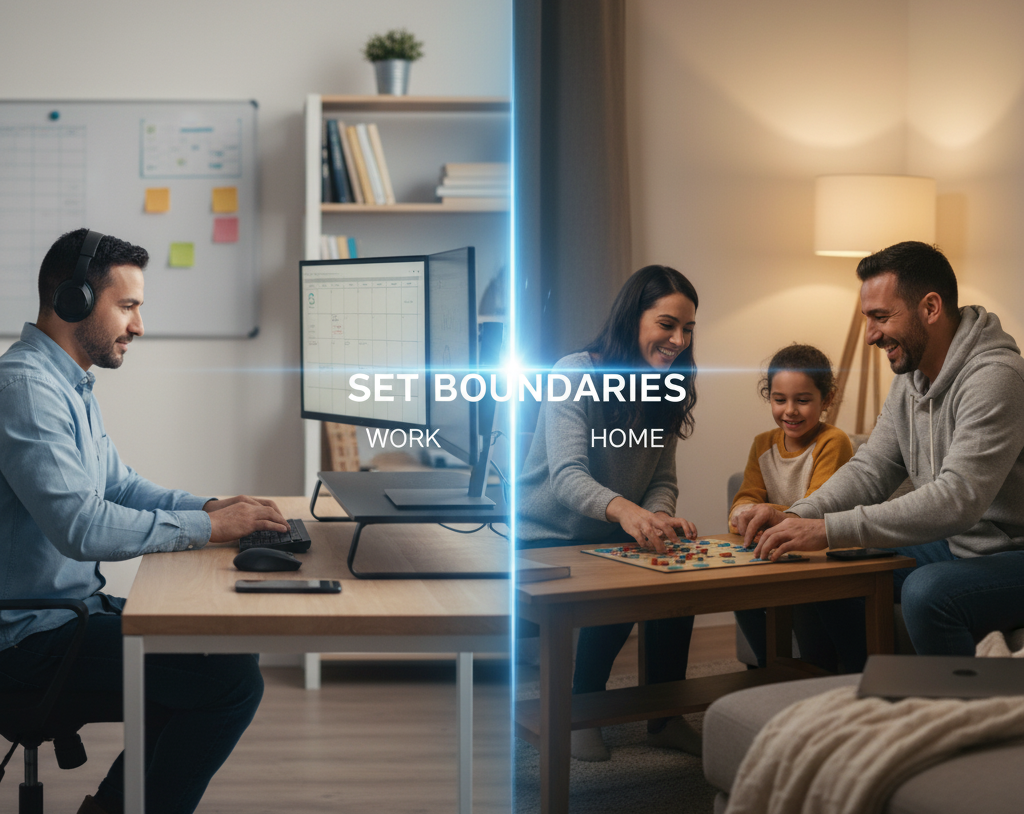Introduction
Working from home sounds like a dream: no commute, flexible hours, and the comfort of your own space. But behind that freedom lies a major challenge: setting boundaries. When your living room becomes your set boundaries working from home office, the lines between personal and professional life blur quickly. Suddenly, the workday never really ends, and “just one more email” turns into hours of overtime.
Many remote workers struggle to separate work from life. The constant accessibility of digital communication and the pressure to stay productive make it difficult to disconnect. Without boundaries, burnout becomes inevitable.
In today’s world, where remote and hybrid work have become the new normal, learning to set clear boundaries is not just a good habit; it’s essential for your mental health, productivity, and long-term success. Let’s explore practical, proven ways to maintain balance while thriving in a work-from-home setup.
Recognize the Importance of Boundaries
Why Boundaries Matter in Remote Work
When you work from home, your personal and professional worlds merge into one physical space. Without clear limits, work can easily creep into your evenings, weekends, and even personal relationships. This constant overlap often leads to stress and reduced focus.
Setting boundaries isn’t about being rigid; it’s about protecting your time and energy. Clear boundaries help you stay productive during work hours and truly rest afterward. They also signal to others, your manager, coworkers, and family when you’re available and when you’re not.
Mental Health and Work-Life Balance
A healthy boundary system directly supports mental well-being. Studies show that employees who separate work from personal life report 30% lower stress levels and improved overall satisfaction. By defining limits, you create space for hobbies, exercise, and meaningful personal time, all of which fuel creativity and long-term motivation.

Create a Dedicated Workspace
The Psychology of Space
Your environment shapes your mindset. When you work from set boundaries working from home the same spot where you relax, your brain struggles to switch between “work mode” and “home mode.” A dedicated workspace, even if it’s a small desk in a corner, helps create a mental boundary between your professional and personal life.
Choose a location in your home that’s quiet, comfortable, and free from distractions. Keep it organized and visually separate from your leisure area. Over time, your brain will start to associate that space with productivity and focus, making it easier to disconnect once you leave it.
Simple Ways to Define Your Work Zone
You don’t need a full home office to set boundaries. Use small cues to signal the start and end of your workday. For instance:
- Keep your work laptop and materials in one specific area.
- Close your laptop and tidy up at the end of the day.
- Use a specific light, scent, or playlist to start and end your work hours.
These micro-habits train your mind to recognize when it’s time to work and when it’s time to stop.
Set Clear Working Hours and Stick to Them
The Discipline of a Routine
One of the most effective ways to set boundaries while working from home is by defining your working hours. Choose a consistent schedule that aligns with your company’s expectations and your own energy levels. Communicate these hours to your team clearly, and make them visible in your online calendar or email signature.
Consistency creates predictability for you and those around you. It helps your set boundaries working from home coworkers know when to reach out and when to respect your personal time. It also gives structure to your day, helping you avoid overwork and unnecessary guilt for logging off.
How to Enforce Time Boundaries
The key is not just setting hours but enforcing them. Turn off work notifications after hours, avoid checking emails late at night, and learn to say “no” when tasks can wait until the next day.
If you live with family or roommates, communicate your schedule to them as well. A simple conversation can prevent misunderstandings like mid-meeting interruptions or loud activities during focus hours. Setting expectations upfront keeps your workday smoother and your relationships stronger.
Use Technology to Protect Your Time
Leverage Tools for Focus and Balance
Technology can be both a blessing and a curse in remote work. It connects us easily, but it also keeps us “on” all the time. The trick is using tech smartly to support your boundaries, not break them.
Use digital tools to manage time, track tasks, and signal availability. Apps like Clockify, Notion, or Google Calendar help you structure your day. Communication platforms like Slack and Teams often allow you to set “away” or “focus” statuses, helping colleagues know when you’re unavailable.
Digital Detox and Downtime
Equally important is the need to disconnect. Constant screen exposure can lead to fatigue and stress. Schedule short breaks away from screens, take a walk, stretch, or enjoy a meal without checking notifications.
Consider implementing “tech-free hours” after set boundaries working from homer work, where you completely detach from professional communication. Even 30–60 minutes of device-free time can significantly recharge your mind and help you transition from work mode to personal time.
Communicate and Reinforce Boundaries Effectively
Be Transparent with Your Team
Boundaries only work if others know they exist. Be proactive about communicating your working preferences with your manager and coworkers. Let them know when you’re most productive, your response hours, and when you’re offline. This transparency builds trust and prevents unnecessary conflicts.
For instance, you might say, “I’m available for meetings between 10 a.m. and 5 p.m., but I’ll respond to emails sent after that the next morning.” Such clarity not only sets expectations but also models healthy behavior for others on your team.
Train Others to Respect Your Limits
Sometimes, colleagues or clients may unintentionally cross set boundaries working from home boundaries. It’s okay to remind them politely. You can use phrases like:
- “I’ll get back to you first thing in the morning.”
- “I’m offline after 6 p.m., but let’s reconnect tomorrow.”
- “I’ll schedule a time to discuss this during my working hours.”
Consistent communication helps people understand your limits. Over time, they’ll adapt to your rhythm, allowing for smoother collaboration without burnout.
Maintain Boundaries Through Self-Discipline and Reflection
Avoid Overworking Yourself
Setting boundaries is one thing; sticking to them requires discipline. Remote workers often fall into the trap of “just finishing one more thing.” Over time, this habit leads to exhaustion. Remind yourself that productivity isn’t measured by how long you stay online but by the quality of work you produce.
Set alarms or reminders to log off at the end of your workday. Use rituals like changing clothes, stepping outside, or journaling to mentally close your workday. These simple cues signal to your brain that it’s time to shift gears.
Reflect and Adjust Regularly
Boundaries are not static. As your workload, team, or lifestyle changes, revisit your limits and adjust them as needed. Reflect weekly on questions like:
- Did I work more hours than planned?
- Did I feel rested after logging off?
- Did my boundaries help or hinder productivity?
This reflection keeps you accountable and ensures your system continues to serve you. Remember, boundaries should make life easier, not add stress.
Conclusion
Working from home offers incredible freedom, but without boundaries, that freedom can become overwhelming. Setting limits around your time, space, and communication isn’t selfish; it’s smart. Boundaries protect your focus, your health, and your happiness.
By creating structure, communicating clearly, and respecting your own time, you build a sustainable rhythm that supports both productivity and peace of mind. The ultimate goal of remote work isn’t to blend life and work; it’s to balance them.
So, define your limits, respect them, and encourage others to do the same. In doing so, you’ll not only work better but live better too.
Find Your Dream Job Today Explore Endless Career Opportunities and Secure Your Next Role with Best Job Tool







Leave a Reply